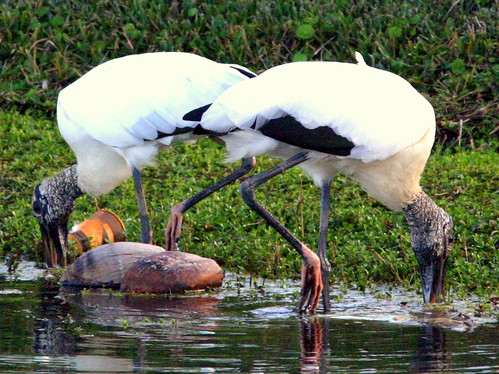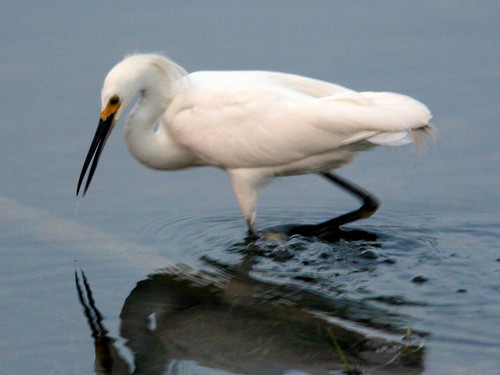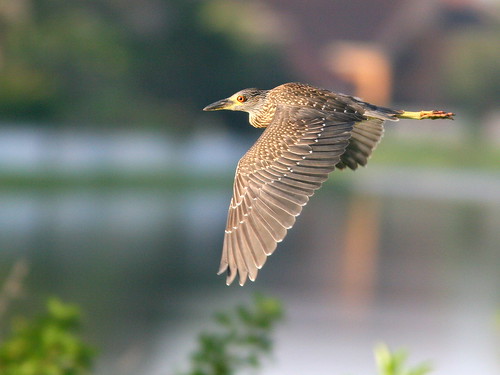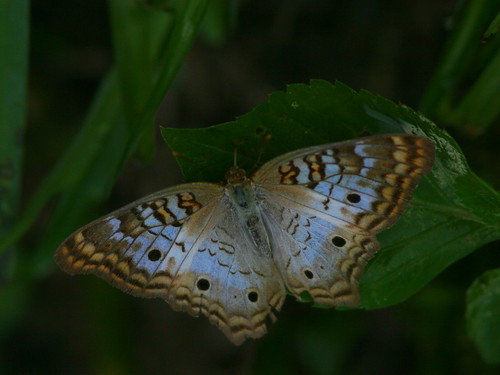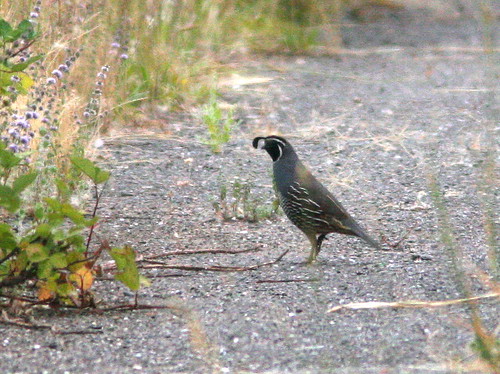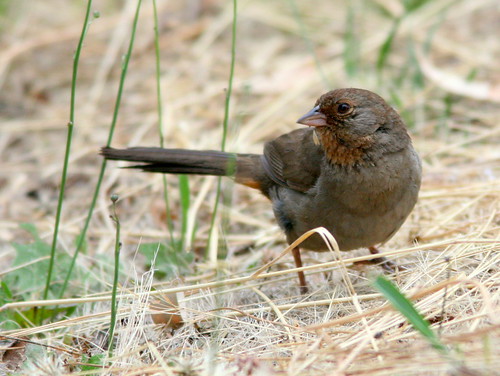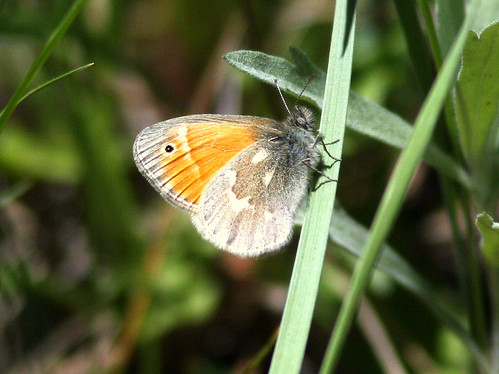Posted by: Ken @ 10:16 am
Finding and identifying birds can be an end in itself, but paying special attention to what birds are doing adds an important dimension to birding. As you can tell from the following photos, we are back in our Florida home. On our first day back, in between the usual chores associated with relocation, I glanced out the back patio window.
Three male Boat-tailed Grackles were assembled breast to breast, their bills pointing to the sky:
In our neighborhood there are many nests of this conspicuous and noisy species. But the nests are hard to find, as most are hidden high in the base of palm fronds. We know the nests are there when adults start carrying food to the nestlings. Just as bull Elk collect harems of cows, the male Boat-tails stand guard over a group of females, and confront other males that enter their territory, which they advertise by calling (”singing”) and flapping from some high vantage point. One male has selected the peak of our roof to conduct such a display.
Conflicts are frequent, but they are almost always non-violent.Instead of engaging in battle, the dominant males rule by intimidation. Subordinate males often are accepted peacefully, as they may be permitted to forage within the territory. The ruling male seems to recognize subtle signs that certain other males pose a threat, and he may chase them away. As I watched the three birds in the above photo, it appeared that they were engaged in an aggressive display. After a minute or so, one of the males stopped displaying and simply walked away. The other two continued displaying. Then one of the resulting pair departed, and the “winner” stayed in place. Although I could not tell the differences between the nature of each bird’s posture and vocalization, it appeared that the remaining bird had indeed prevailed over the other two in a bloodless contest.
Wild creatures have evolved ways to conserve precious energy, and this “Cold War” is probably an example of one such adaptation. (I wish we humans could make such progress!) Interestingly, studies have shown that a significant majority of the the females in a “harem” of Boat-tailed Blackbirds are actually impregnated by males other than the dominant one– the equivalent of “spies?” (See: http://www.allaboutbirds.org/guide/Boat-tailed_Grackle/lifehistory )
A young Boat-tailed Grackle, as big as its mother and actually able to find food on its own, pesters Mama for a handout: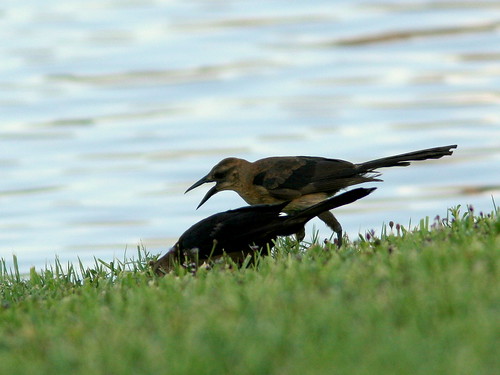
This photo shows an interaction between two Common Grackle males, part of a large flock that gathered in the wetlands adjacent to our property. This exchange seems not to be hostile:
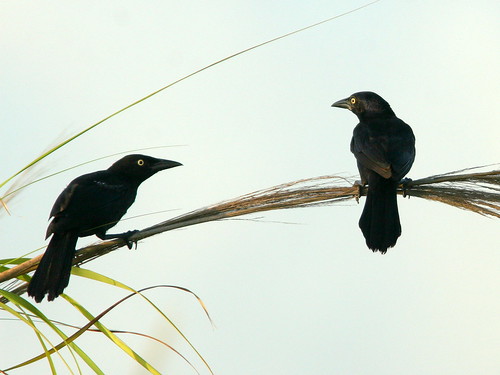
Here, a Fish Crow seems to enjoy harassing a Black Vulture atop the handball court of a nearby park: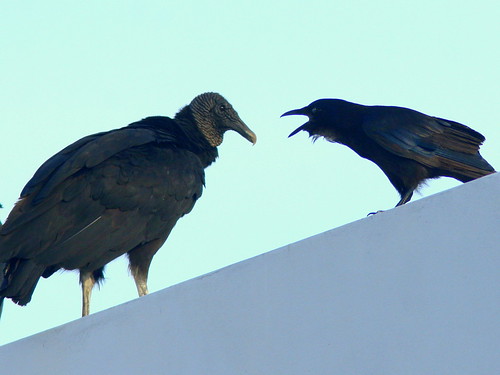
Along the edge of our lake, I saw another interesting behavior. Wood Storks are tactile feeders, with bubble-gum colored toes. Maybe their toes look like worms to attract prey into their waiting open jaws.
A pair of Wood Storks were stirring the water with their feet, which startles small fish into the trap:
Snowy Egrets hunt by sight, but they also stir their “golden slippers,” driving fish out of hiding places: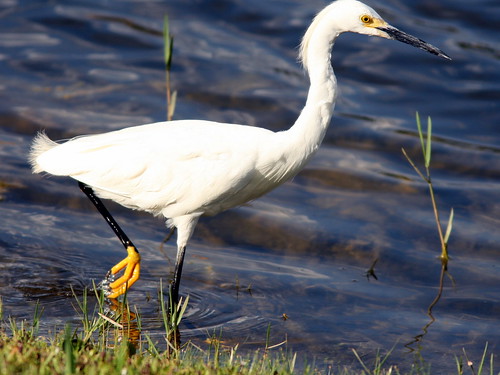
Behavior-watching provides insights into the many aspects of the life history of birds. The best places to find birds is in areas where prey is most abundant. This makes identification and better understanding of prey species a valuable asset for birders.
I was puzzled about the identity of this very large grub as it struggled in the beak of a Loggerhead Shrike:
I recognized the grub as an arthropod larva of some kind, but had never seen one this big– over two inches long. With some help from an online friend, I learned that this creature is the larval form of a Horsefly. These insects develop in the mud on the bottom of canals, and the larva can deliver a painful bite. The shrike had just carried its prey from the edge of a nearby ditch.
Mockingbirds have conspicuous white patches on their wings. When foraging in the grass, they often open their wings, presumably to scare insects into moving.
This immature Northern Mockingbird has breast streaks which will fade over the next couple of months: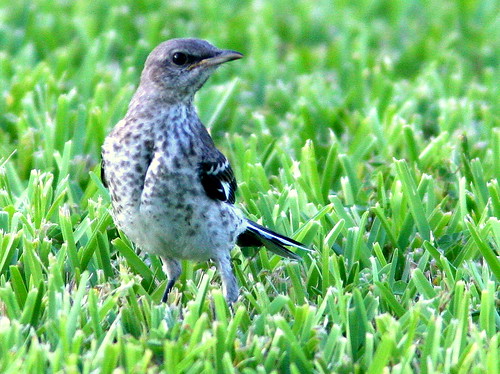
While the wing patches of the mockingbird appear to serve a useful purpose, why does this Common Nighthawk have white wing bars?:
When a friend asked me this question, I speculated:that, as with almost anything in nature, those wing spots must have a purpose, or they would not have evolved. Perhaps some ornithologist has already done research, such as covering the patches to see if they provide some advantage. Maybe they are vestiges of a trait that has become less useful as feeding habits evolved. The male has more prominent white wing bars than the female, which suggests they may provide a reproductive advantage.
Since nighthawks are crepuscular feeders and also perform courtship when the sky is quite dark, perhaps the white bars provide recognition. White-tailed deer use their white “flags” in this manner, so the members of a herd can follow each other in the dark. But, honestly I do not know, and it is a good question, for which I will try to find an answer. (Here is a link to a Blackfeet Indian legend about how the white got onto nighthawks’ wings, and also why the bird’s beak is so short)
Small things about birds can also be quite fascinating. Look at the eyes of the birds in the above photos, Boat-tailed Grackles in Florida have dark eyes, while those to the north and west have straw-colored eyes. Those Common Grackles have bright yellow eyes. See how the nighthawk’s eyes face forward to provide binocular vision,
Most of the Eastern Towhees in South Florida have yellow eyes. This red-eyed one is either an exception or an early migrant from the north:

Speaking of eyes, check out those of this immature Yellow-crowned Night-Heron that I flushed from the trailside ditch:
When birding gets dull, I tend to pay more attention to the insects. Interactions between butterflies can be interesting. For example, the White Peacock butterfly males can be seen patrolling back and forth along the paths. Almost like the grackles, the male will protect its territory against other males, and attempt to mate with any females that enter it. Since the females of this species can mate only once, they will spurn the advances of any male who did not get to her first.
The color of White Peacocks is said to change from very pale during the dry (winter) season to darker after the summer rains begin. I have taken quite a few photos of this species and cannot see a clear trend. However, the lighting conditions can produce quite different impressions of their color.
This White Peacock was photographed in full sun:
A few minutes later, I shot this one in a shady spot:
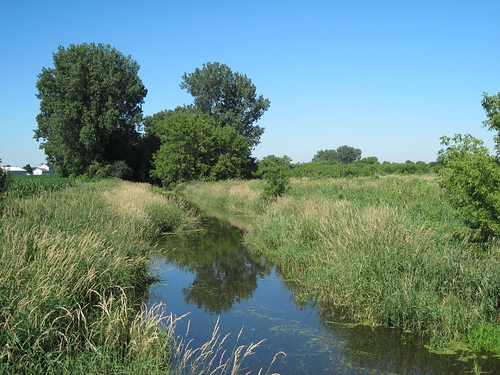
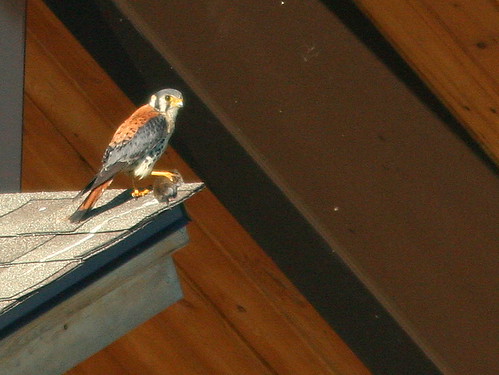
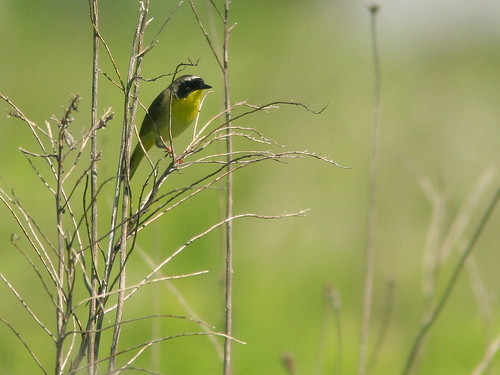

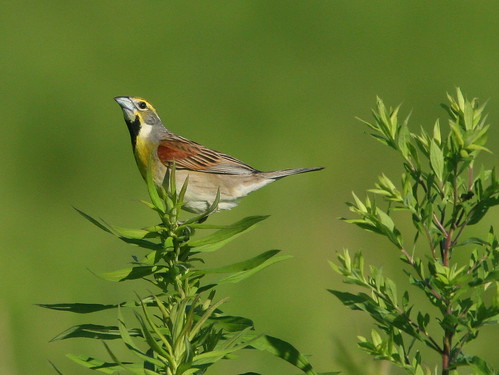


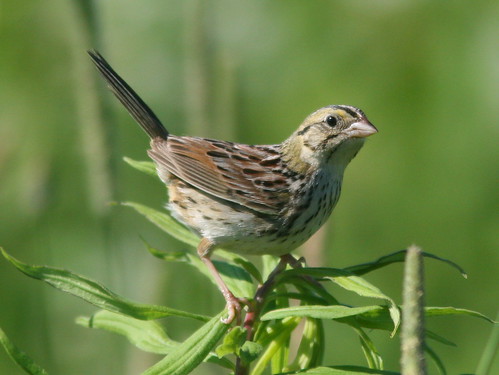
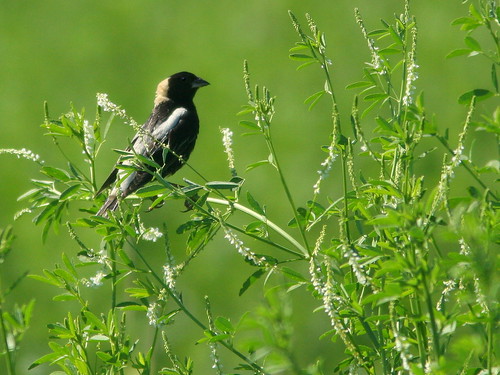

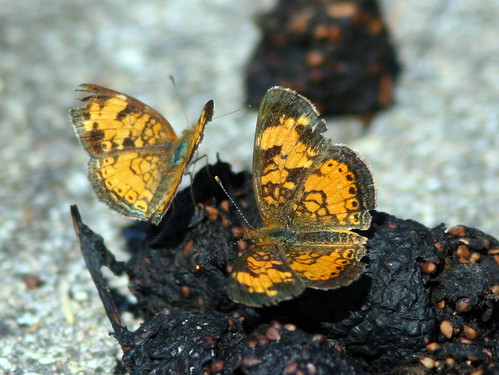
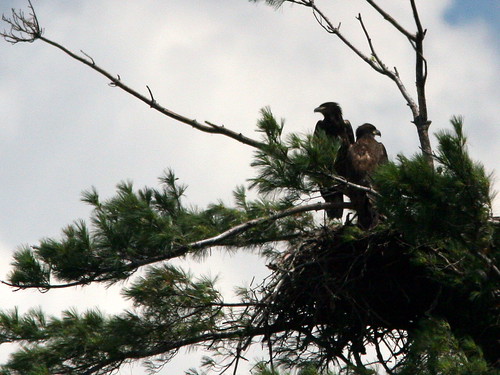
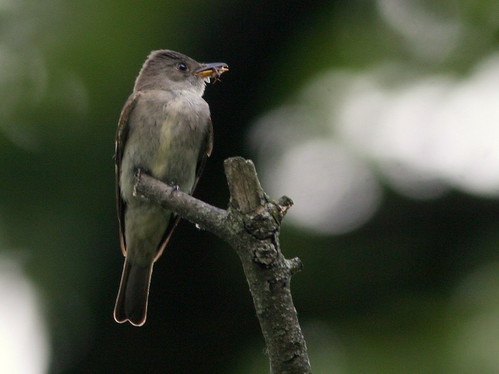
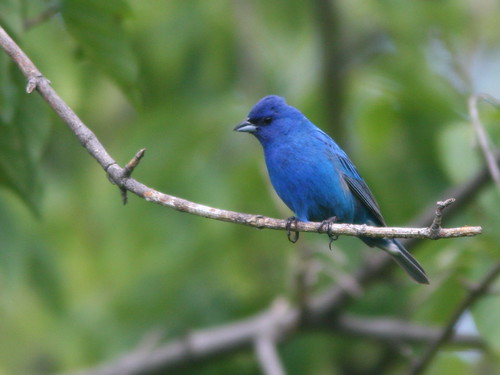



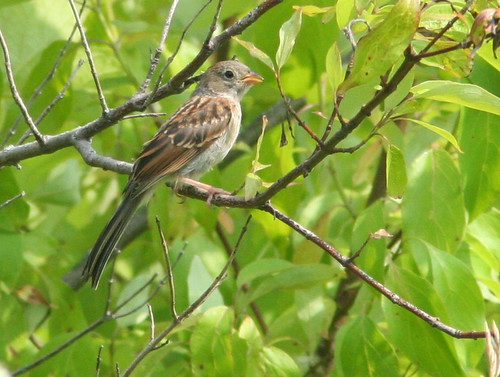
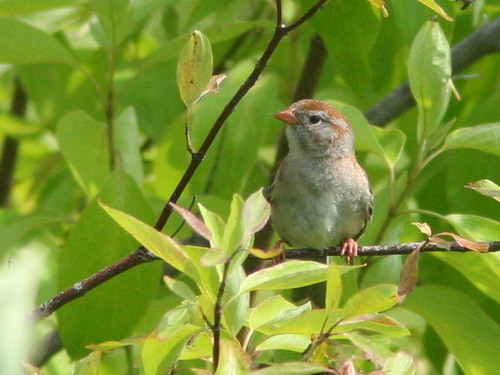

Posted by: Ken @ 3:28 pm
(This is a continuation of the previous post)
We topped off our two week 50th Anniversary trip with 5 nights at the Hilton Sonoma Wine Country Hotel in Santa Rosa, California. Transportation and lodging were a gift from our younger daughter and her husband, in exchange for our agreement to mind their two daughters while they attended the wedding (and several associated gatherings) of a friend and business associate. Needless to say, we welcomed the task and found it to be a most pleasant “burden.” The younger set enjoyed sleeping late on their vacation, while we persisted in our habit of being up and out at the crack of dawn. This provided a nice window of “prime time” for birding. Since we did not have a car, we had to find a nearby place to bird.
Mornings started out quite cool and foggy, but once the skies cleared, the temperature rose rapidly, and Our granddaughters enjoyed the hotel pool:
As soon as we arrived at the hotel, Mary Lou and I scouted out the neighborhood in search of the nearest patch of natural habitat that might be a convenient birding site. Only about a block from the hotel entrance, we found an undeveloped hill that was covered by grass and had patches of shrubs and trees. Blackberry thickets laden with near-ripe fruit bordered an old trail that led to a long-abandoned building. We were greeted by California Towhees and two California Quail. Unfortunately, I did not bring my camera, so the above image was taken from a much greater distance a couple of days later,
We had birded in California a couple of times before, so we did not expect to see any new species. Since we tend to be more “bird-watchers” than compulsive “listers,” this was not a concern. Birding in a new and less familiar location is always exciting, and we looked forward to get re-acquainted with species not present back in our Florida and Illinois homes.
Almost immediately, we heard the calls of a colony of Acorn Woodpeckers. This fascinating species breeds cooperatively, with one or two dominant males in charge of a group of subordinate males and females (the latter usually siblings from a previous brood). All assist in maintaining the colony. They store acorns, as well as other nuts and seeds, individually in holes they drill in the bark of trees in their territory. Most of the holes were created by many previous generations of Acorn Woodpeckers, and are used year after year. Telephone poles and fence posts, and even cracks in boulders and stone walls may serve as “granaries.” They are even known to drill storage holes into rock themselves. For much more information about this behavior, see this article (PDF) from the University of New Mexico SORA collection of ornithology literature: http://elibrary.unm.edu/sora/wb/v23n04/p0165-p0170.pdf
Two Acorn Woodpeckers took positions at the top of one of their larder trees: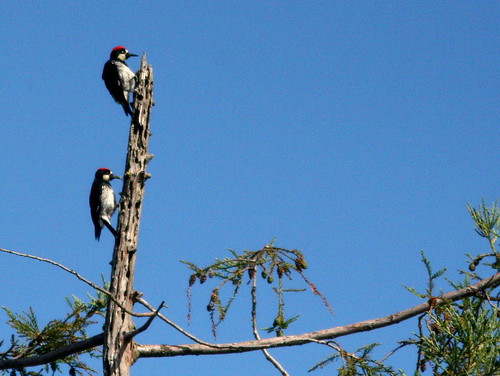
A Spotted Towhee sang a weak trill. Its bright red eyes differed from the yellow eyes of the closely related Eastern Towhees in South Florida: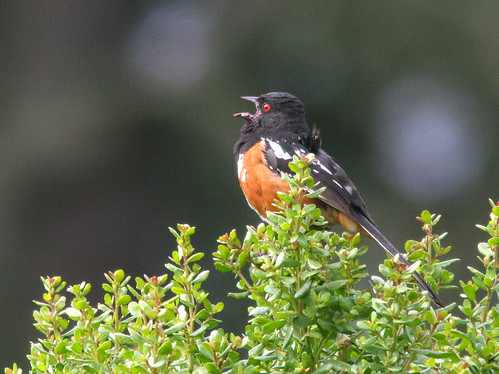
The area surrounding our new-found birding “patch” is mostly developed, with office buildings and medical clinics, as well as vineyards. Open land appeared to be fragmented, and our birding spot was an island of wildness.
We did see several deer, including this young Black-tailed buck. This species is smaller and darker than the Mule Deer (which is believed to have evolved thousands of years ago from hybrids of White-tailed and Black-tailed Deer):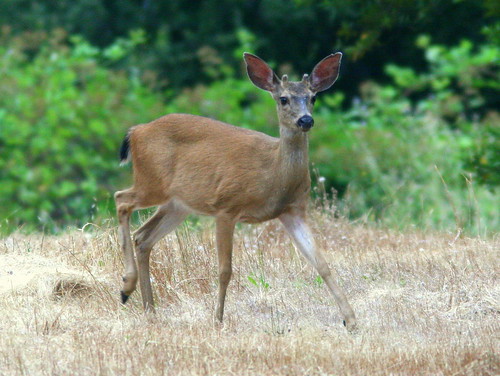
On our last morning in Santa Rosa we got a late start, and the day quickly turned quite warm. Mary Lou was anxious to get back to bring the girls swimming, but I stayed out for another hour. I was rewarded by the appearance of a small flycatcher. It had the tear-drop shaped eye ring of the Cordillerian Flycatcher, a familiar and common species around our former home in the mountains of New Mexico. However, this was my first sighting of a West Coast specialty, the Pacific-slope Flycatcher. I felt bad that Mary Lou missed out on a “lifer.”
The Pacific-slope Flycatcher was classified as a subspecies of the Cordillerian until taxonomists “split” it into a new species. But for its unique calls and song, it is practically indistinguishable from its eastern counterpart:
This view better displays the “tear drop” eye ring: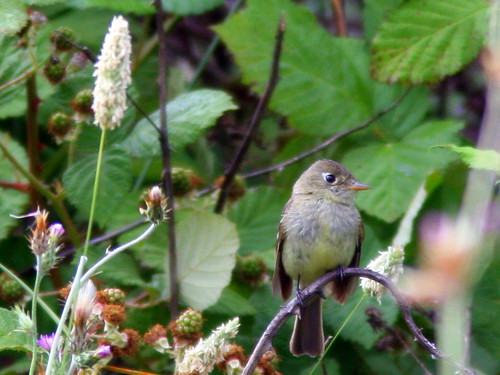
That same morning, a few swifts flew over. I paid them little mind until I realized that they were not Chimney Swifts, so common east of the Rocky Mountains, but Vaux’s (rhymes with “boxes”) Swifts. While they are smaller than the Chimney Swift, and are said to fly with more rapid wingbeats, all I could say, without any basis for comparison, is that they did fly fast and were small– so fast and small that my attempts to capture photos of them produced only blue sky and a few clouds! We had seen the species before from a distance, flying into a chimney roost in Portland, Oregon, but that view was unsatisfactory. I had to go back to my records to see if we had ever entered it as a new “life” bird. We had not, so with some hesitancy I added it this time as my Life Bird Number 574. At my age, I believe there is little hope for me to reach the 600 species milestone.
We saw a few Bewick’s Wrens, but they were quite elusive:
We drove down to Point Reyes National Seashore, where we visited the Visitors Center, and the girls hugged an Elephant Seal:
The spectacular drive down to Muir Woods followed State Route 1:
At Muir Woods, the girls were given Junior Ranger badges and they recorded their observations in notebooks. A wary Chipmunk is under study:
An endangered Leopard Lily grows in John Muir Woods: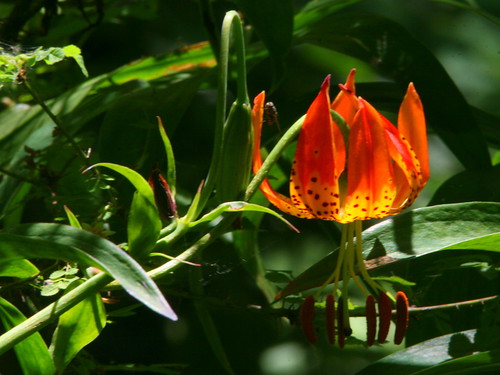
(This series of three posts begins at this link)
Posted by: Ken @ 3:34 pm
YMCA entrance sign:
(Continuation of previous post)
We last visited the YMCA of the Rockies in Estes Park, Colorado several times in the 1970s and ’80s, when I attended continuing medical education conferences of the American Academy of Family Physicians. I combined the trips with a few vacation days. We’d pack our children into the station wagon and drive up from Dallas. The children were kept busy with Day Camp programs, and the conference schedule allowed us for family fun, such as hay rides, hiking and sightseeing. Although the facility is now much larger, the cabins are stil fairly secluded. As their parents had before them, our grandchildren also enjoyed a wonderful selection of Day Camp activities.
Our cabin (Robin’s Nest), at 8,500 feet elevation, was flanked by those of our children and grandchildren:
Missing from this photo of the Schneider clan are our daughter Karen and her husband Randy, who had to return home because of his brother’s sudden death, and our son-in-law Roly, who took the picture:
Bachelor groups of elk gathered near the cabins. In the fall they will fill the air with their bugling, and compete with each other as they assemble the females into harems: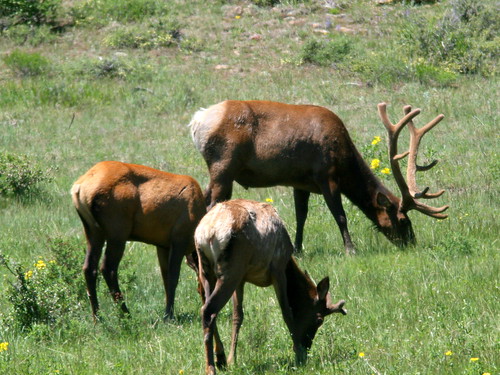
A Pine Siskin gathered nesting materials beside our cabin:
This Tiger Swallowtail provided a photo-op::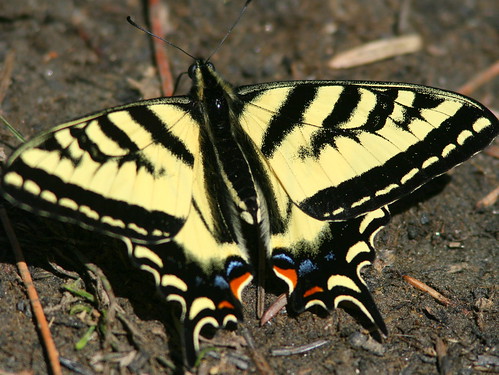
Having left my butterfly guide back in Florida, I found this Common Ringlet, a species that has expanded its range southward from Canada:
We joined our younger daughter and family on a scenic drive through southern Colorado to New Mexico, staying two nights at The Inn on the Delta in Espanola:
The rooms were cozy and luxurious:

A male House Sparrow perched in the Inn’s courtyard:
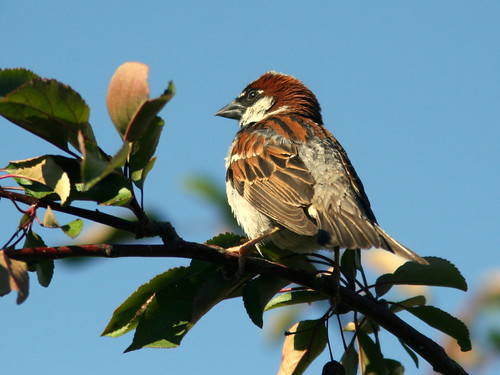
We made side trips to Abiquiu and Ghost Ranch, NM, and to Taos Pueblo. The vibrant colors and forbidding topography of Ghost Ranch inspired many of Georia O’Keefe’s paintings:
The hills, sculpted by wind and water, are rich in fossils:
Remarkably, a pair of Barn Swallows had plastered their mud nest on the smooth metal surface of one of the portal lights at the museum at Ghost Ranch: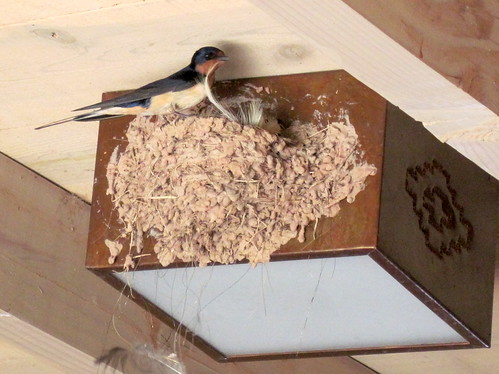
After two nights in Espanola, we departed for Albuquerque by way of Santa Fe, where St. Francis of Assisi Cathedral loomed over the old city:
In Santa Fe’s Central Plaza, our granddaughters made friends with two vendors and a macaw: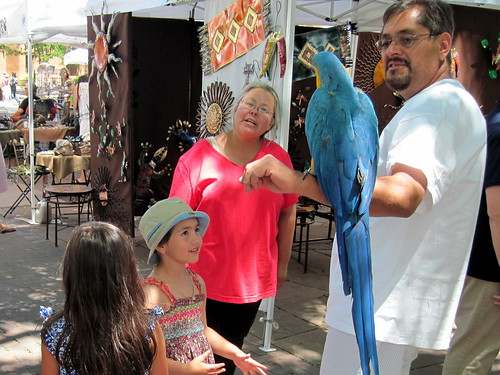
Following the Turquoise Trail southward, we drove up to Sandia Crest before descending into Albuquerque. The hummingbird feeder at Crest House attracted quite a crowd of Broad-tailed Hummiingbirds. Here, a male hovers, a mile above the City of Albuquerque: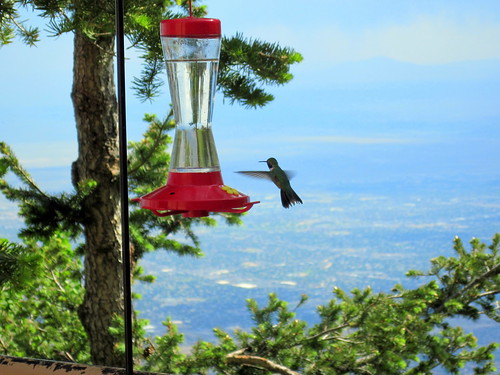
Before departing for California, we visited the ancient Acoma Pueblo, situated west of Albuquerque, high on an arid mesa. At bottom of this page, view a slide show of the Pueblo (select full screen mode). This is the Acoma mission church:













